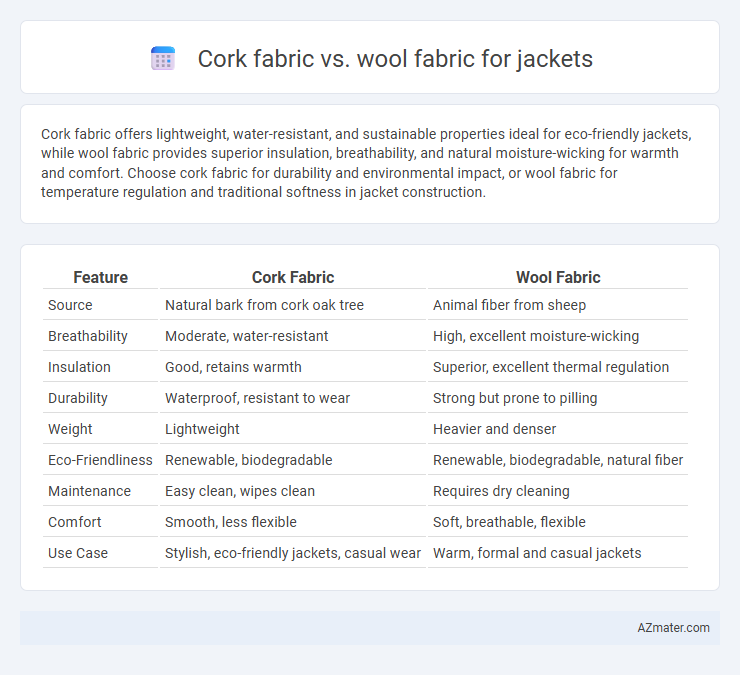Cork fabric offers lightweight, water-resistant, and sustainable properties ideal for eco-friendly jackets, while wool fabric provides superior insulation, breathability, and natural moisture-wicking for warmth and comfort. Choose cork fabric for durability and environmental impact, or wool fabric for temperature regulation and traditional softness in jacket construction.
Table of Comparison
| Feature | Cork Fabric | Wool Fabric |
|---|---|---|
| Source | Natural bark from cork oak tree | Animal fiber from sheep |
| Breathability | Moderate, water-resistant | High, excellent moisture-wicking |
| Insulation | Good, retains warmth | Superior, excellent thermal regulation |
| Durability | Waterproof, resistant to wear | Strong but prone to pilling |
| Weight | Lightweight | Heavier and denser |
| Eco-Friendliness | Renewable, biodegradable | Renewable, biodegradable, natural fiber |
| Maintenance | Easy clean, wipes clean | Requires dry cleaning |
| Comfort | Smooth, less flexible | Soft, breathable, flexible |
| Use Case | Stylish, eco-friendly jackets, casual wear | Warm, formal and casual jackets |
Introduction to Cork Fabric and Wool Fabric
Cork fabric, derived from the bark of cork oak trees, offers a sustainable, lightweight, and water-resistant alternative for jacket materials, featuring natural breathability and hypoallergenic properties. Wool fabric, sourced from sheep fleece, provides exceptional insulation, durability, and moisture-wicking capabilities, making it a classic choice for warmth and comfort in jackets. Both fabrics present unique advantages in terms of texture, environmental impact, and performance in outerwear applications.
Origins and Production of Cork and Wool Fabrics
Cork fabric originates from the bark of the cork oak tree (Quercus suber), primarily found in Mediterranean regions like Portugal and Spain, where the bark is sustainably harvested every 9 to 12 years without harming the tree. Wool fabric is derived from the fleece of sheep, with major production hubs in Australia, New Zealand, and the United Kingdom, involving processes like shearing, cleaning, carding, and spinning to create durable textile fibers. Cork fabric offers a lightweight, water-resistant alternative with natural elasticity, while wool provides excellent insulation and moisture-wicking properties through its dense protein fibers.
Sustainability and Environmental Impact
Cork fabric, harvested from the bark of cork oak trees without harming them, offers a renewable and biodegradable alternative to traditional wool fabrics, which require extensive land, water, and methane-emitting livestock farming. The production of cork fabric generates minimal carbon emissions and supports cork oak ecosystems that promote biodiversity and prevent desertification. Compared to wool, cork fabric reduces environmental degradation and provides a cruelty-free, recyclable option for sustainable jacket manufacturing.
Durability and Longevity Comparison
Cork fabric exhibits exceptional durability due to its natural elasticity and water-resistant properties, making it resistant to tearing and environmental damage, ideal for long-lasting jackets. Wool fabric provides strong resilience through its dense fiber structure, offering excellent insulation and resistance to wear while maintaining breathability and flexibility over time. Comparing longevity, cork jackets often outperform wool in moisture-heavy conditions, whereas wool excels in maintaining structural integrity and warmth during extended cold weather use.
Comfort and Breathability Factors
Cork fabric offers exceptional breathability due to its natural cellular structure, allowing moisture to escape and keeping the wearer dry and comfortable. Wool fabric excels in temperature regulation by trapping air within its fibers, providing warmth while still maintaining breathability to prevent overheating. Both materials deliver comfort in different climates, with cork being lightweight and hypoallergenic, and wool offering resilience and moisture-wicking properties ideal for cooler environments.
Water Resistance and Weather Protection
Cork fabric offers exceptional water resistance due to its natural waxy coating, making it highly effective against rain and moisture compared to traditional wool fabric. Wool provides moderate water repellency through its tightly woven fibers and lanolin content, which also offers good insulation and breathability in varying weather conditions. When choosing between the two for jackets, cork fabric excels in waterproof performance, while wool ensures better thermal regulation and comfort in cold, damp climates.
Care and Maintenance Requirements
Cork fabric requires minimal maintenance, needing only occasional wiping with a damp cloth to remove dirt, making it highly water-resistant and durable for jackets. Wool fabric demands more careful care, including regular brushing to prevent pilling, gentle washing or dry cleaning, and protection from moths to maintain its softness and shape. Both materials benefit from proper storage away from direct sunlight and moisture to extend jacket longevity.
Aesthetic Appeal and Style Options
Cork fabric offers a unique, eco-friendly texture with a smooth, natural finish that gives jackets a modern, minimalist aesthetic, ideal for sustainable fashion enthusiasts. Wool fabric provides classic warmth and a timeless look with rich texture variations such as tweed, herringbone, and flannel, offering versatile style options from formal to casual. Cork's lightweight, water-resistant properties contrast with wool's insulating capabilities, making each fabric distinct in both appearance and functional wardrobe appeal.
Cost-Effectiveness and Value
Cork fabric offers a cost-effective alternative to wool, with lower production expenses and durability that extends jacket lifespan, reducing replacement frequency. Wool fabric, while often pricier, provides superior insulation and breathability, enhancing comfort in cold climates and justifying its premium cost through long-term wear. Choosing between cork and wool depends on balancing initial investment with functional benefits and maintenance costs for optimal jacket value.
Verdict: Choosing the Ideal Jacket Fabric
Cork fabric offers exceptional sustainability and water resistance, making it an excellent choice for eco-conscious consumers seeking lightweight and durable jackets. Wool fabric provides superior insulation, breathability, and natural moisture-wicking properties, ideal for colder climates where warmth and comfort are priorities. The ideal jacket fabric depends on the specific needs for weather protection, environmental impact, and intended use, with cork favored for sustainability and weather resistance, while wool excels in thermal performance and classic appeal.

Infographic: Cork fabric vs Wool fabric for Jacket
 azmater.com
azmater.com